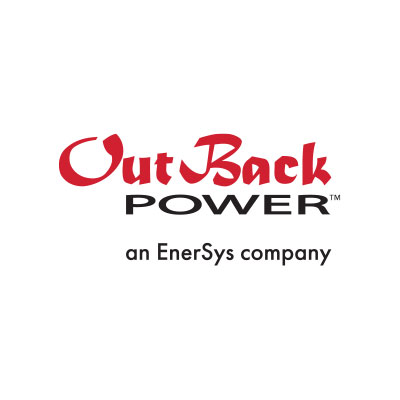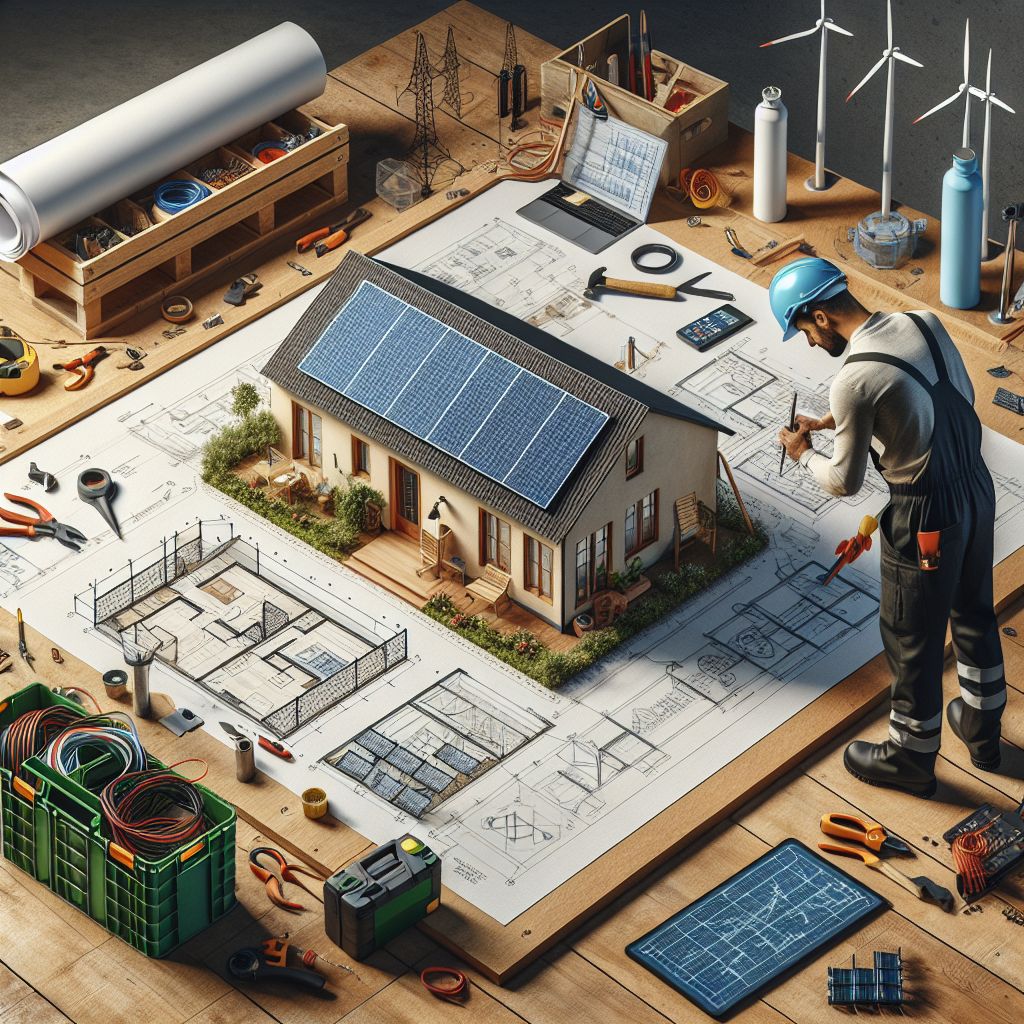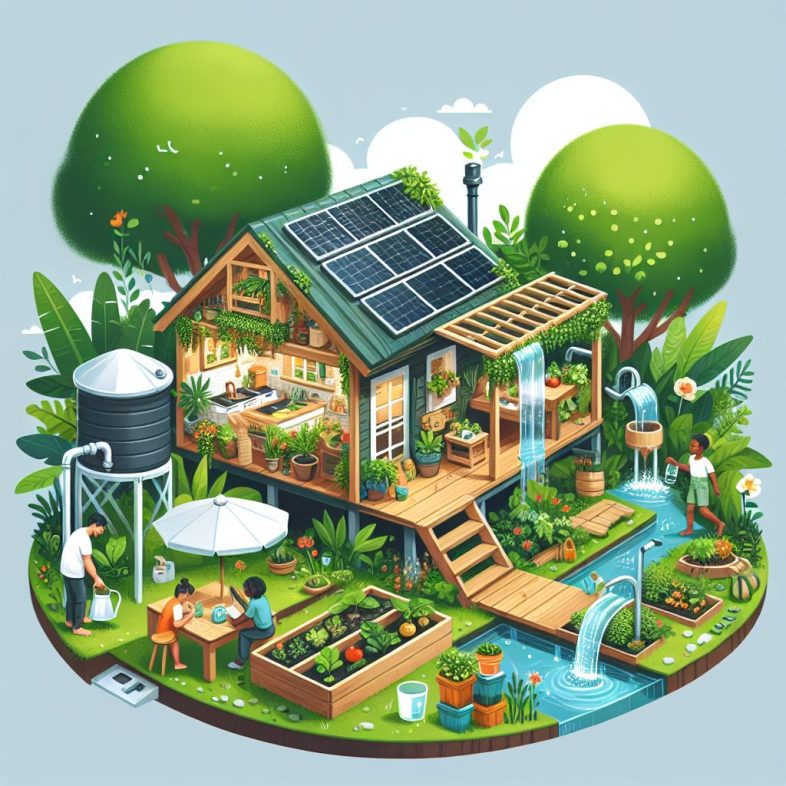Key Takeaways
-
Self-sustained home systems offer the benefits of energy independence and cost savings.
-
OutBack Power Systems provides reliable components for off-grid living.
-
Inverters, solar panels, and batteries are key components of a self-sustained home.
-
Knowing your energy requirements is essential for designing an efficient off-grid system.
-
Renewable energy sources such as solar, wind, and hydro can be used for self-sufficiency.

“Outback Power” from www.bcew.com and used with no modifications.
Claim Your Energy Independence with OutBack Power Systems
Picture a life where power outages are a distant memory and your energy bills are practically zero. This isn’t some far-off dream; it’s a real possibility with self-sustained home systems. As we explore the realm of off-grid living, you’ll learn how to tap into nature’s power to build a comfortable, sustainable home for you and your loved ones.
Trailblazing Self-Sustained Living
While off-grid living has been around for some time, the technology that makes it a reliable and accessible option is certainly modern. A self-sustained home system is one that functions independently of the traditional power grid, drawing power from natural resources. This independence not only lowers your carbon footprint but also provides unmatched resilience during power outages.
Living off-grid is about independence, and that means having the right tools for the job. OutBack Power Systems is a leader in this field, providing efficient, easy-to-use solutions. These systems are perfect for anyone who’s ready to fully embrace a self-sustained way of life.
What You Need to Power Your Home
Here’s what you’ll need for a self-sustained home system:
-
An inverter/charger that transforms the DC power produced by solar, wind, or hydro sources into AC power.
-
Solar panels or other renewable energy systems that generate electricity.
-
A battery bank that stores energy for times when your renewable sources are not producing.
-
A charge controller that controls the flow of electricity and safeguards your batteries.
These components work in harmony to provide a steady flow of energy from the natural world to your household appliances. With OutBack’s dependable technology, you can be confident that your system will continue to perform well for many years.
The Advantages of Opting for Self-Sustained Power
Deciding to go off-grid with a self-sustained home system isn’t just about being green—it’s also a wise economic decision. After the initial setup costs, your energy bills can plummet as you’re no longer reliant on utility companies. Additionally, many areas provide incentives for installing renewable energy, which can help cover your initial investment.
Economic and Ecological Benefits
There are more benefits to off-grid living than just the financial ones:
-
Diminished or even eradicated monthly energy expenses.
-
Potential boost in property worth due to the integration of renewable energy systems.
-
Decrease in greenhouse gas emissions, promoting a healthier world.
These benefits make the transition to a self-sustained system not just a personal benefit but a contribution to the worldwide fight against climate change.
Dependability and Independence in Energy Supply
Crucially, a self-sustained home system gives you peace of mind. You’re no longer dependent on the whims of power outages or volatile energy prices. Instead, you have a dependable, consistent power source that you have complete control over.
OutBack Power Systems doesn’t just sell you a product, they provide you with the means to change your lifestyle, to be both self-sufficient and responsible. It’s about managing your own energy needs, and knowing that each kilowatt-hour you consume is one that you’ve produced.
Storing Power: How to Choose the Best Batteries
Batteries are the heart of any off-grid home system. They hold the power harvested from your renewable energy sources, ready for you to use anytime. The trick is to find batteries that not only last a long time, but also match your unique energy needs and usage habits.
For power supply during the night or on cloudy days, you will require a battery bank that can meet your home’s energy needs. Although lead-acid batteries have been the go-to option, lithium-ion batteries are gaining popularity because they last longer and are more efficient.

Designing and Building Your Off-Grid System
Designing your off-grid system is a crucial step towards achieving energy freedom. You’ll need to measure your energy usage, comprehend the local climate and weather trends, and plan for both present and future energy demands. While this may seem overwhelming, it’s entirely doable with a well-defined strategy.
Determining Your Power Requirements
Before you begin planning your off-grid system, you’ll need to figure out how much energy you’ll require. Make a list of all your appliances and how much power they consume. Don’t forget to consider not just the daily usage but also the changes in usage throughout the year. For instance, you’ll use more power for heating in the winter and more for air conditioning in the summer.
Creating an Expandable Energy System
After you’ve determined your energy requirements, you can create a system that not only satisfies your present needs but also accommodates future growth. Maybe you’re considering adding an electric vehicle to your home, or perhaps you’re thinking about expanding your house. An expandable system will allow you to incorporate additional panels, batteries, or other components as necessary without having to completely redo your entire setup.
Setting Up Your System
When it comes to setting up your system, it’s recommended to work with experts who have experience with off-grid systems. They can help ensure that all components are set up safely and effectively. Proper setup can greatly affect the performance and lifespan of your system, so this isn’t an area to skimp on.
Combining Different Types of Renewable Energy
While solar power is a fantastic resource, it’s not the only type of renewable energy that you can use for your off-grid system. Wind and hydro power can be great additions to solar, especially in locations where the sun isn’t always shining.
Effective Use of Solar Power
Solar power is the most commonly used source of energy for off-grid systems due to its widespread availability and ease of harnessing. To effectively use solar power, it is important to use high-quality panels and to place them in a location where they will receive the most sunlight. Tracking systems can also be used to follow the sun’s path throughout the day, which increases efficiency.
Considering Wind and Hydro Power
Properties that are located in windy areas or have access to a flowing water source may find wind or hydro power to be a good fit. These options can be especially beneficial during the winter months when there is less sunlight for solar power. However, these power sources do require specific conditions in order to work well, so it’s important to evaluate whether they are feasible before making an investment.
Success Stories from the Real World
It’s always inspiring to hear about people who’ve successfully switched to a self-sustained home system. These real-world examples can help you see how feasible it is to live off the grid with OutBack Power Systems.
Pioneers of Off-Grid Living
Consider the tale of a family that constructed their ideal home in the mountains. With no grid connection available, they relied on OutBack Power Systems to develop a strong off-grid configuration. They now live comfortably, free from the burden of energy bills and the uncertainty of the grid.
Seeing OutBack’s Cutting-Edge Solutions in Practice
Take, for example, the isolated island community that swapped out their diesel generators for a green, renewable system from OutBack. This change not only lessened their environmental footprint but also drastically lowered their energy expenses, demonstrating that sustainability and cost-effectiveness often coincide.

Keeping Your Off-Grid Power Systems Up and Running
Keeping your off-grid home system in top shape requires regular maintenance. This includes cleaning your solar panels, keeping an eye on your battery’s health, and making sure all connections are secure. This can help you catch any potential problems before they become serious.
Don’t forget, a system that is kept in good condition not only has a longer lifespan but also has a better performance. Therefore, establish a maintenance routine and adhere to it. This is the most effective method to safeguard your investment and guarantee a constant power supply for your off-grid house.
Looking Beyond the Horizon
When to Think About System Upgrades
Your energy requirements may change as your lifestyle does. If your current setup isn’t meeting your energy use, it might be time to think about an upgrade. This could involve adding more solar panels, increasing your battery storage, or bringing in new technologies like wind turbines or micro-hydro systems.
Increasing Power for Electric Vehicles and Swimming Pools
As more people are buying electric cars and installing heated pools, you might find that your off-grid system needs a bit more power. The good news is that OutBack Power Systems are designed to grow with you. You can simply add more capacity to your system to make sure that your new car or pool doesn’t leave you in the dark.
Primarily, when you’re augmenting your system, you need to make sure that all the parts work together and that the system is well-adjusted. Overburdening your system could result in inefficiencies or even damage, so it’s best to talk to an expert to make sure you’re doing it correctly. For more insights on building a self-sustained system, consider reading about outdoor and urban survival gear.
Common Questions on Building Self-Sustained Homes with OutBack
How Do I Begin Planning My Off-Grid Home?
Planning is an essential step in moving to an off-grid home. Start by figuring out how much energy you currently use and think about how it might change in the future. Investigate the renewable energy sources in your area and understand the different components needed for an off-grid system. OutBack Power Systems provides resources and tools to help you start off on the right foot.
Is OutBack Power Systems Suitable for Big Homes?
Definitely, OutBack Power Systems can be customized to cater to the needs of any home, regardless of its size. Whether it’s a small cabin or a large mansion, the flexibility of OutBack’s solutions allows you to create a system that fits your unique energy needs.
Knowing how much energy you use and creating a system that fits is crucial. If you have a big house, you’ll probably need a bigger set of solar panels and a larger battery bank. But with OutBack’s product line, you can easily build a strong system.
How Long Does an OutBack Power System Last?
-
OutBack inverters and charge controllers are built to last, often exceeding 10 years with the right maintenance.
-
The lifespan of a battery depends on its type and usage, with lithium-ion batteries typically outlasting lead-acid.
-
With the right care and maintenance, your OutBack system can provide dependable power for many years.
How Do I Keep Track of and Manage My Off-Grid System?
Keeping an eye on and managing your off-grid system is essential for maintaining its efficiency and longevity. OutBack Power Systems offers management tools that let you see your system’s performance in real-time. Regular checks of your system help catch any potential problems early, ensuring your system keeps running at its best. For more detailed insights, check out these survival skills that can be beneficial for off-grid living.
By monitoring how much energy you use and produce, you can make changes to enhance efficiency and avoid unnecessary use. This active strategy is key to maintaining your off-grid system.
“The secret to a thriving off-grid system isn’t only about the quality of the parts, but also how well you comprehend and control your energy consumption. Armed with the proper tools and information, you can make sure your system stays productive and potent for a long time.”
How Can I Find Out More About OutBack Power Systems?
When you’re ready to delve deeper into the details of creating a self-sustained home with OutBack Power Systems, there’s a wealth of information at your fingertips. Check out their website for comprehensive product details, useful planning aids, and motivating success stories. Plus, their customer service team is always on standby to help with any queries and walk you through the steps.
If you’re the type who learns best by doing, OutBack also offers training sessions and webinars. You’ll gain priceless knowledge on how to design, install, and maintain your off-grid system.
Whether you’re just beginning to consider the possibility of off-grid living or you’re seeking to enhance your current setup, OutBack Power Systems has the knowledge and goods to assist you in achieving your objectives. So why put it off any longer? Take the first step toward genuine energy freedom today and find out more about what OutBack can do for you.
Off-Grid Freedom: Building Your Self-Sustained Home with OutBack Power Systems.


